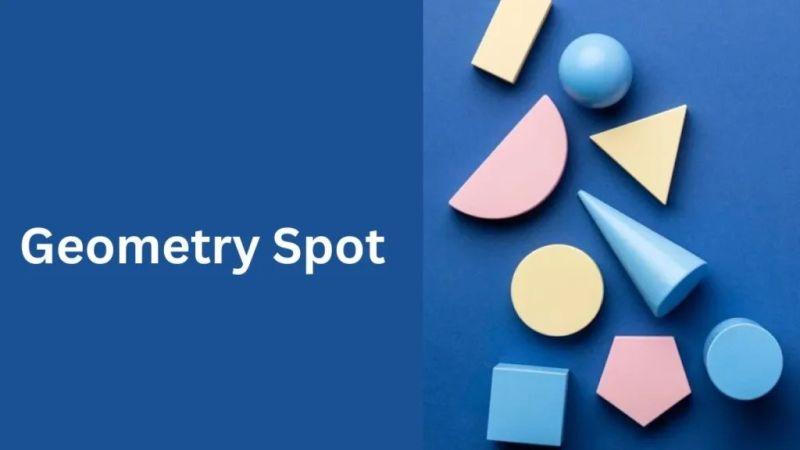Introduction
Geometry Spot is your go-to resource for mastering geometry concepts. Whether you’re a high school student struggling with shapes and angles or someone preparing for advanced mathematics exams, Geometry Spot provides essential guidance and tips to make learning geometry fun and easy.
In this article, we’ll share the best tips and strategies to help you understand geometry concepts more clearly and effectively.
Understanding the Basics: Start with Key Definitions

The foundation of geometry lies in understanding its basic definitions. Geometry Spot encourages students to start by familiarizing themselves with fundamental terms like points, lines, angles, and shapes. These building blocks are essential for grasping more complex concepts later on.
For instance, a point is a specific location in space, a line extends infinitely in both directions, and an angle is formed when two lines meet. Knowing these definitions is key to solving geometry problems effectively.
Visual Learning: Use Diagrams and Drawings
One of the best tips for learning geometry is to embrace visual learning. Geometry Spot recommends that students use diagrams and drawings to make sense of geometric shapes and figures. Sketching out problems helps you visualize the relationships between different parts of the figure, making them easier to solve.
Whether it’s a triangle, rectangle, or circle, drawing out the shape can make it much clearer. Practice sketching different types of angles, polygons, and 3D objects to strengthen your understanding.
Mastering Geometry Formulas
Geometry is full of formulas used to calculate area, perimeter, volume, and surface area of various shapes. Geometry Spot suggests memorizing these essential formulas to make problem-solving faster and more efficient. For example, the area of a rectangle is calculated by multiplying its length by width, while the volume of a cube is found by cubing the length of its side.
Some key formulas to remember include:
- Area of a circle: A = πr²
- Perimeter of a rectangle: P = 2(l + w)
- Surface area of a sphere: SA = 4πr²
By practicing these formulas, you will build confidence and improve your geometry problem-solving skills.
Break Down Complex Problems into Steps
Geometry problems can sometimes feel overwhelming, but Geometry Spot recommends breaking them down into smaller steps. Start by identifying the given information, the unknowns, and the relationships between different parts of the figure.
For example, if you are asked to find the missing angle of a triangle, first identify what angles are known and apply the properties of triangles (e.g., the sum of angles in a triangle is always 180°). Breaking problems into smaller parts will help you stay organized and solve them more efficiently.
Use Online Tools and Resources

There are plenty of online tools and resources available to help you understand geometry better. Geometry Spot recommends using interactive tools, videos, and educational websites to reinforce your learning. Websites like GeoGebra and Khan Academy offer interactive exercises that make learning geometry more engaging.
By using online resources, you can get a deeper understanding of geometric principles through practice and visual aids, which will boost your confidence when tackling problems in class or on exams.
Practice, Practice, Practice!
Like any other subject, practice is key to mastering geometry. Geometry Spot suggests regularly practicing geometry problems to reinforce what you’ve learned. The more problems you solve, the more familiar you will become with different types of geometric figures and the various ways they can be manipulated.
Create a study routine where you dedicate a certain amount of time each day to solving geometry problems. You can use textbooks, online resources, or worksheets to find practice problems that will test your knowledge and improve your skills.
Understand the Importance of Proofs
In higher-level geometry, proofs are a crucial part of understanding theorems and postulates. Geometry Spot advises students to take the time to understand the logic behind geometric proofs. A proof demonstrates why a certain geometric statement is true, step by step.
Learning how to write and understand proofs might seem challenging at first, but once you understand the structure of a proof, it will become easier. Start with simple proofs, such as proving that the sum of the angles of a triangle is 180°, and work your way up to more complex ones.
Learn the Properties of Different Shapes
Understanding the properties of different geometric shapes is essential for solving geometry problems. Geometry Spot encourages students to pay attention to the unique properties of common shapes like triangles, squares, circles, and polygons.
For example:
- A right triangle has one 90-degree angle.
- A parallelogram has opposite sides that are equal and parallel.
- A circle has a constant radius from its center to any point on its circumference.
By knowing these properties, you will be able to identify the best approach for solving problems involving these shapes.
Focus on Geometry Applications in Real Life
Geometry is not just a subject you study for exams—it’s a skill that has real-life applications. Geometry Spot suggests finding ways to apply geometry to everyday situations to make learning more relatable and fun.
For instance, you can calculate the area of a room to determine how much paint you need or use the concept of symmetry to design a logo. Geometry is used in fields like architecture, engineering, and even art, so understanding its applications will help you see its value in the real world.
Seek Help When You Need It

If you ever feel stuck or confused, don’t hesitate to seek help. Geometry Spot emphasizes the importance of asking for assistance when needed. Whether it’s a teacher, tutor, or study group, getting help can clarify difficult concepts and boost your confidence.
Consider joining online forums or study groups where you can ask questions, share ideas, and learn from others who may have a better understanding of the topic.
Take Breaks to Avoid Overwhelm
While studying geometry, it’s important to take breaks and avoid burnout. Geometry Spot suggests that you break your study sessions into manageable chunks and take short breaks in between. This approach will help you retain information better and reduce stress.
For example, after studying for 30 minutes, take a 5-10 minute break to relax, stretch, or do something enjoyable. This will refresh your mind and allow you to return to your studies with a clearer focus.
Track Your Progress
To stay motivated, it’s important to track your progress as you learn geometry. Geometry Spot recommends that you monitor how well you’re doing by regularly reviewing your practice problems and tests. This will help you identify areas that need improvement and celebrate your successes.
By tracking your progress, you can adjust your study routine and focus on areas where you need more practice.
Stay Positive and Be Patient
Geometry can be challenging, but with the right attitude, you can overcome any obstacles. Geometry Spot reminds students to stay positive and be patient with themselves. Learning geometry is a gradual process, and improvement takes time.
When you make a mistake, don’t get discouraged. Instead, learn from it and keep moving forward. A positive mindset will help you stay motivated and committed to mastering geometry.
Conclusion
In conclusion, mastering geometry doesn’t have to be overwhelming. With the tips and strategies shared by Geometry Spot, you can improve your understanding of geometry concepts and perform well in your studies.
By focusing on key definitions, using visual aids, practicing regularly, and seeking help when needed, you can navigate the world of geometry with confidence and ease.
Whether you’re preparing for an exam or just trying to improve your skills, Geometry Spot is here to guide you every step of the way. Remember, the key to success is consistent effort, and with the right resources, geometry will become a subject you not only understand but also enjoy.
FAQs
1. What is Geometry Spot?
Geometry Spot is a comprehensive online resource designed to help students understand and master geometry concepts. It provides tips, resources, and tools for learning geometry effectively.
2. How can I improve my geometry skills?
To improve your geometry skills, practice regularly, use visual aids, memorize formulas, and break down problems into smaller steps. You can also seek help when needed and take breaks to avoid overwhelm.
3. Are there any online resources for learning geometry?
Yes, online resources like GeoGebra, Khan Academy, and various math-focused websites offer interactive tools, videos, and practice problems to help you understand geometry better.





